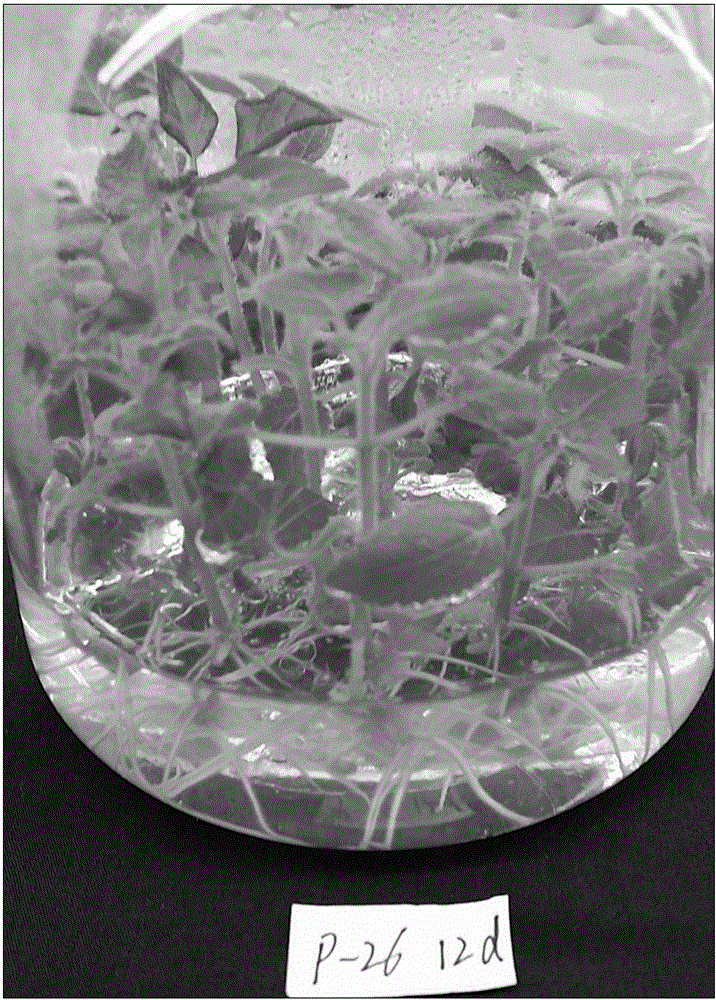Non-toxic paulownia fortunei seedling culture method
A cultivation method, the technology of Paulownia albicans, applied in horticultural methods, botanical equipment and methods, horticulture, etc., can solve the problems affecting seedling quality, reproduction rate, rooting rate and survival rate, affecting seedling washing efficiency and transplanting survival rate, The detoxification time of tissue culture materials is long and other problems, so as to improve the efficiency of seedling washing and transplanting survival rate, high proliferation and rooting efficiency, and high rooting rate
- Summary
- Abstract
- Description
- Claims
- Application Information
AI Technical Summary
Problems solved by technology
Method used
Image
Examples
Embodiment 1
[0032] 1) Using the stem segment of Paulownia albaflora (the Paulownia albaflora is an excellent clone of Paulownia albaflora obtained by screening according to the existing conventional screening method) with axillary buds from the Paulownia albaflora in the Guangxi Institute of Botany in northern Guangxi as an explant, place Soak in detergent solution with a mass concentration of 1% for 10 minutes, take it out and rinse it under running tap water, then place it on an ultra-clean workbench and soak it in ethanol with a volume concentration of 70% for 60 seconds, take it out and place it in a mass concentration 0.1% HgCl 2 Soak in water for 7 minutes, take it out, and wash it 5 times with sterile water;
[0033] 2) Inoculate the sterilized explants in the first-generation culture medium, cultivate them under light for 30 days, and develop and grow the axillary buds of the explants to form 2-3cm high sprouts (such as figure 1 shown), that is, the primary seedlings; wherein, th...
Embodiment 2
[0063] 1) Using the stem segment of Paulownia albaflora (the Paulownia albaflora is an excellent clone of Paulownia albaflora obtained by screening according to the existing conventional screening method) with axillary buds from the Paulownia albaflora in the Guangxi Institute of Botany in northern Guangxi as an explant, place Soak in detergent solution with a mass concentration of 1% for 10 minutes, take it out and rinse it under running tap water, then place it on an ultra-clean workbench and soak it in ethanol with a volume concentration of 70% for 50 seconds, take it out and place it in a mass concentration 0.1% HgCl 2 Soak in water for 6 minutes, take it out, and wash it 4 times with sterile water;
[0064] 2) Inoculate the sterilized explants in the first-generation culture medium, and cultivate them under light for 25 days. The axillary buds of the explants develop and grow, forming sprouts with a height of 2-3 cm, which are the first-generation seedlings. The resulting...
Embodiment 3
[0070] 1) Take the stem section with axillary buds of Paulownia albiflora (the Paulownia albiflora is an excellent clone C001 of Paulownia albiflora) as an explant, soak it in a detergent solution with a mass concentration of 1% for 10 minutes, take it out, and place it under flowing tap water Rinse it clean, then place it on the ultra-clean workbench and soak it in ethanol with a volume concentration of 75% for 70s, take it out and place it in HgCl with a mass concentration of 0.2% 2 Soak in water for 8 minutes, take it out, and wash 5 times with sterile water;
[0071] 2) Inoculate the sterilized explants in the first-generation culture medium, and cultivate them under light for 25 days. The axillary buds of the explants develop and grow, forming sprouts with a height of 2-3 cm, which are the first-generation seedlings. The resulting seedlings are strong, the leaves are bright green, and grow Good, induction rate 60%; wherein, the formula of the primary medium is: MS+6-BA 4....
PUM
| Property | Measurement | Unit |
|---|---|---|
| Reproduction coefficient | aaaaa | aaaaa |
| Reproduction coefficient | aaaaa | aaaaa |
| Reproduction coefficient | aaaaa | aaaaa |
Abstract
Description
Claims
Application Information
 Login to View More
Login to View More - R&D Engineer
- R&D Manager
- IP Professional
- Industry Leading Data Capabilities
- Powerful AI technology
- Patent DNA Extraction
Browse by: Latest US Patents, China's latest patents, Technical Efficacy Thesaurus, Application Domain, Technology Topic, Popular Technical Reports.
© 2024 PatSnap. All rights reserved.Legal|Privacy policy|Modern Slavery Act Transparency Statement|Sitemap|About US| Contact US: help@patsnap.com










